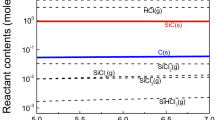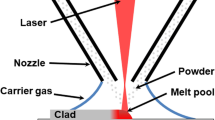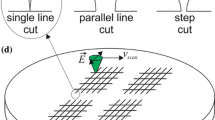Abstract
The trend towards using a large area of thin-film transistor liquid crystal display (TFT-LCD) glass substrate introduces challenges for cutting quality and production yield. For the requirements of boosting manufacturing efficiency and reducing cost, the optimization of cutting parameters becomes very important. In this study, we use a cutting wheel to directly scribe the glass substrate so as to generate a cutting score depth of the glass. The glass is then cleaved utilizing the principles of mechanical stress. We investigate quality issues such as median crack, lateral crack, cutting score, and cleaved profile with respect to different cutting pressures and wheel depths, which are in the ranges of 0.16 to 0.24 MPa and 0.1 to 0.3 mm, respectively, with a cutting speed of 350 mm/s. The glass substrate for the experiment is Corning EAGLE 2000 with a thickness of 0.7 mm. It is found that the median and lateral crack length can reach 140 and 403 μm, respectively, when the cutting pressure increases to 0.24 MPa.
Similar content being viewed by others
References
Ono T, Tanaka K (2001) Effect of scribe-wheel dimensions on the cutting of AMLCD glass substrates. J Soc Inf Disp 9(2):87–94
Yilbas BS (2004) Laser cutting quality assessment and thermal efficiency analysis. J Mater Process Technol 155–156:2106–2115
Nikumb S, Chen Q, Li C, Reshef H, Zheng HY, Qiu H, Low D (2005) Precision glass machining, drilling and profile cutting by short pulse lasers. Thin Solid Films 477:216–221
Quintero F, Pou J, Lusquinos F, Boutinguiza M, Soto R, Perez-Amor M (2004) Quantitative evaluation of the quality of the cuts performed on mullite-alumina by Nd:YAG laser. Opt Lasers Eng 42(3):327–340
Ono T, Tanaka K (2004) Cuttability of AMLCD glass substrates using a four-point-bending test. Corning Incorporated technical information paper: 304/1–304/7
Liu G, Toncich DJ, Harvey EC (2004) Evaluation of excimer laser ablation of thin Cr film on glass substrate by analysing acoustic emission. Opt Lasers Eng 42:639–651
Tsai CH, Chen HW (2003) Laser cutting of thick ceramic substrates by controlled fracture technique. J Mater Process Technol 136:166–173
Prakash ES, Sadashivappa K, Joseph V, Singaperumal M (2001) Nonconventional cutting of plate glass using hot air jet: experimental studies. Mechatronics 11:595–615
Tsai JF, Hsieh PL (2005) A cutting and manufacturing optimization method for TFT-LCD industry. The 35th International Conference on Computers and Industrial Engineering 1953–1958
Zhou M, Ngoi BKA, Yusoff MM, Wang XJ (2006) Tool wear and surface finish in diamond cutting of optical glass. J Mater Process Technol 174(1–3):29–33
Krohn MH, Hellmann JR, Shelleman DL, Pantano CG, Sakoske GE (2002) Effect of enameling on the strength and dynamic fatigue of soda-lime-silica float glass. J Am Ceram Soc 85(10):2507–2514
Wiederhom SM, Dretzke A, Rodel J (2002) Crack growth in soda-lime-silicate glass near the static fatigue limit. J Am Ceram Soc 85(9):2287–2292
Kirugulige MS, Tippur HV (2006) Mixed-mode dynamic crack growth in functionally graded glass-filled epoxy. Exp Mech 46(2):269–281
Abrams MB, Green DJ, Glass SJ (2003) Fracture behavior of engineered stress profile soda lime silicate glass. J Non-Cryst Solids 321(1):10–19
Nakamura M, Sumomogi T, Endo T (2003) Evaluation of surface and subsurface cracks on nano-scale machined brittle materials by scanning force microscope and scanning laser microscope. Surf Coat Technol 169–170:743–747
Lin JT, Chen YY (2007) A multi-site supply network planning problem considering variable time buckets- A TFT-LCD industry case. Int J Adv Manuf Technol 33:1031–1044
Wang PS, Su CT (2006) An optimal yield mapping approach for the small and medium sized liquid crystal displays. Int J Adv Manuf Technol 27:985–989
Ya LL, Zhang FH (2006) Parameters of cutting and splitting glass substrates process of TFT-LCD. Chin J Liq Cryst Disp 21(1):43–47
Tsai CH, Lin BC (2007) Laser cutting with controlled fracture and pre-bending applied to LCD glass separation. Int J Adv Manuf Technol 32:1155–1162
Author information
Authors and Affiliations
Corresponding author
Rights and permissions
About this article
Cite this article
Pan, C.T., Hsieh, C.C., Su, C.Y. et al. Study of cutting quality for TFT-LCD glass substrate. Int J Adv Manuf Technol 39, 1071–1079 (2008). https://doi.org/10.1007/s00170-007-1293-4
Received:
Accepted:
Published:
Issue Date:
DOI: https://doi.org/10.1007/s00170-007-1293-4




